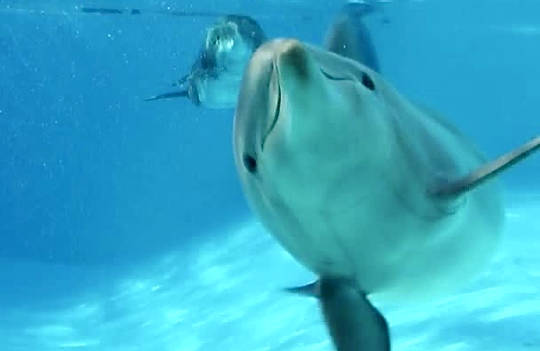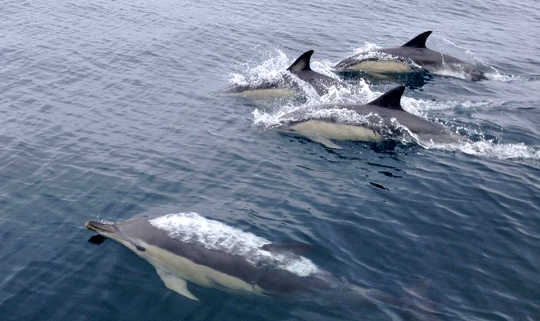
The cognitive bias task involved the dolphins touching the target and returning to the trainer for a reward. Parc Astérix
Some people say the glass is half-empty, some say it’s half-full – but can animals also be optimistic or pessimistic?
Recent studies show that certain animals do make more positive or negative judgements depending on the situation and their emotional state, just like humans. This phenomenon is called cognitive bias.
Cognitive bias is present in many aspects of our lives, whenever we make decisions about events with an unknown outcome. It has been shown that our current emotional state can influence whether decisions are more positive or negative in nature: either we expect the best or prepare for the worst.
Thanks to recent cognition research, we can test this in animals by training them in a judgment task.
Measuring optimism and pessimism
A judgment task works like this: first the animal is taught what will happen when certain cues appear.
For instance, if we place a bowl in the left-hand corner of a room, it means they will receive a big reward. When the bowl is in the right-hand position, this means the animal gets no reward, or something bad will happen (for example, a loud sound is played). Logically, the animal will run faster towards the positive cue and much slower towards the negative cue.
After this priming, the bowl is placed in the middle of the room. If an animal still runs fast to the bowl, it is thought to be more “optimistic”, since it expects something positive to occur from an unknown event.
Past studies involving many species (for example rats, dogs and bees) have used this approach and shown that animals in poorer welfare situations, such as those in barren cages, or those subjected to veterinary exams or social isolation, make more pessimistic judgments. Those in enriched environments make more optimistic judgements.
These experiments lead scientists to believe that cognitive bias testing is a valid way to discover the emotional state of the animal. However, these tests had never been applied to captive dolphins before.
Optimistic dolphins
At the Parc Astérix dolphinarium in France, I led a study to find out whether dolphins also had cognitive biases, and what might influence them.
We taught the parks’ eight dolphins to touch a target and return to their trainer. The dolphins then learnt that if the target was presented on one side of the pool, they would get a big herring (their favorite fish). If the target was on the other side of the pool, they would receive only applause and eye contact from the trainer.
The dolphins were soon swimming faster when the target was in the “herring position”. It was then placed in the middle position and we measured the level of optimism of each dolphin by their swimming speed as they returned to the trainer. Those swimming faster back to the trainer were thought to be more optimistic as they are were probably expecting to receive a herring, while the slower swimmers were not as hopeful about getting a reward.
The results showed that indeed, the dolphins had different levels of optimism and pessimism, which remained the same over repeated days of testing.
But the most interesting discovery came when we compared the cognitive bias with individual observations of behavior taken in the dolphins’ “free-time”, in between the sessions.
In both the wild and captive environments, dolphins engage in social behavior. Swimming in synchrony is thought to be an important affiliative behavior which reinforces the bonding between individuals.
In the park, we observed that those dolphins who swam in synchrony more often were also the ones who made the most optimistic decisions. For example, a 16-year-old female dolphin was seen very often swimming in synchrony with other partners, especially her mother, and during the judgement tests she swam the fastest back from the middle target, thus making an optimistic judgment.

In the wild, dolphins swim together when hunting cooperatively. Vanino/pixabay
As highly social animals, this isn’t entirely surprising, but the link between optimism, positive emotions and social behavior has proved difficult to measure so far. Positive social behavior is an adaptation that is thought to help the dolphins survive in the wild, for example in the cooperative hunting behaviors seen in Florida.
Sociability and emotions
The findings of the cognitive bias study suggest that synchronised swimming is linked to positive emotional states, which for the first time gives us an insight into the emotions linked to dolphins’ social interactions.
Intrigued by the results, our team went one step further and compared optimism levels to the social behavior seen in the four months preceding the test. We had taken daily observations of the dolphins’ social behavior, and measured the amount of time they spent swimming synchronously during the weeks before the test.
We found that the most optimistic dolphins were also those who had performed most synchronised swimming in the two months prior to the test, but that there was no relation between optimism and the behavior before that. This suggests that the optimism levels are linked to emotional states, as opposed to fixed personality characteristics. The emotional states are likely driven by the positive social behavior occurring within the group at that time.
Dolphins’ emotional states, and their overall welfare in captivity, have recently incited much interest for scientists and the public. The authors of this study believe that the level of synchronised swimming could be used as an indicator of emotional state, and thus could help to monitor and improve the animals’ social dynamics.
Our study was small, and more work is needed to investigate the link between welfare and positive social behavior, but it is encouraging that these types of studies can yield such fruitful results and enhance our knowledge of dolphins’ social lives.![]()
About The Author
Isabella Clegg, PhD student in Dolphin Behaviour and Welfare, Université Paris 13 – USPC
This article was originally published on The Conversation. Read the original article.
Related Books
at InnerSelf Market and Amazon

























